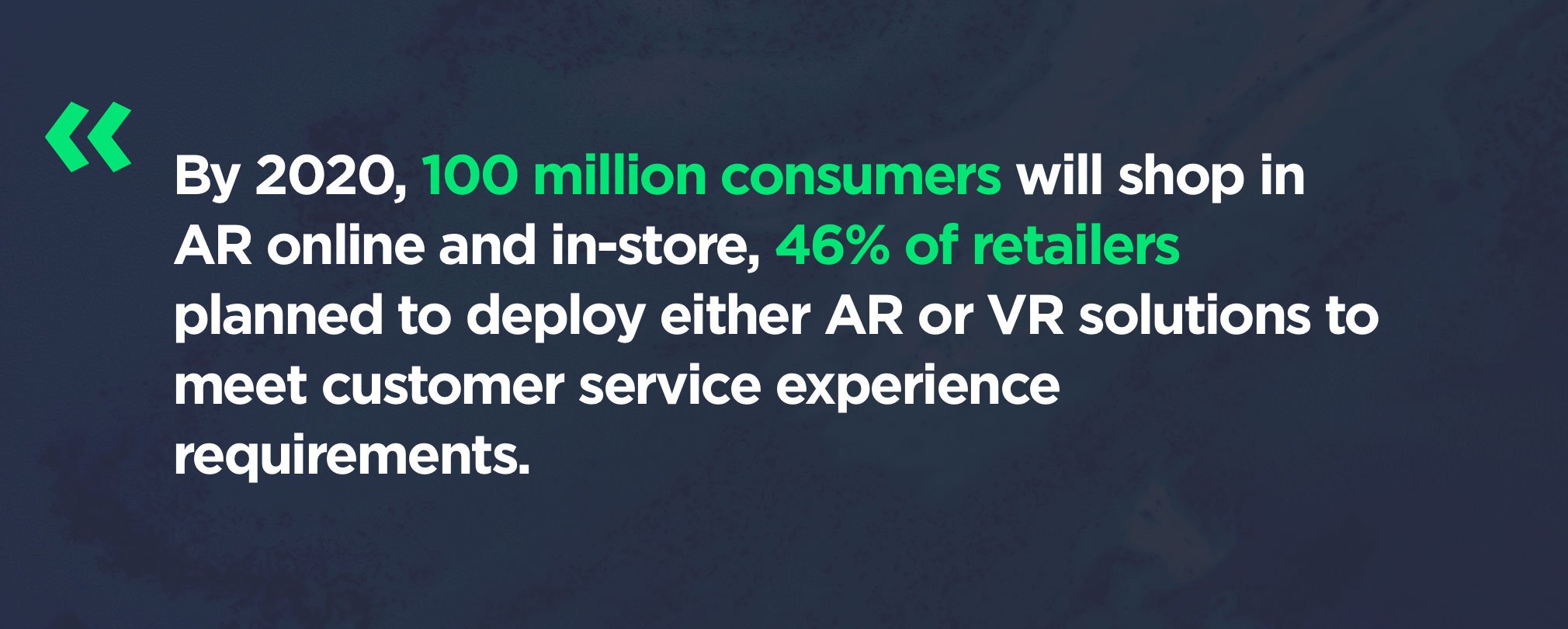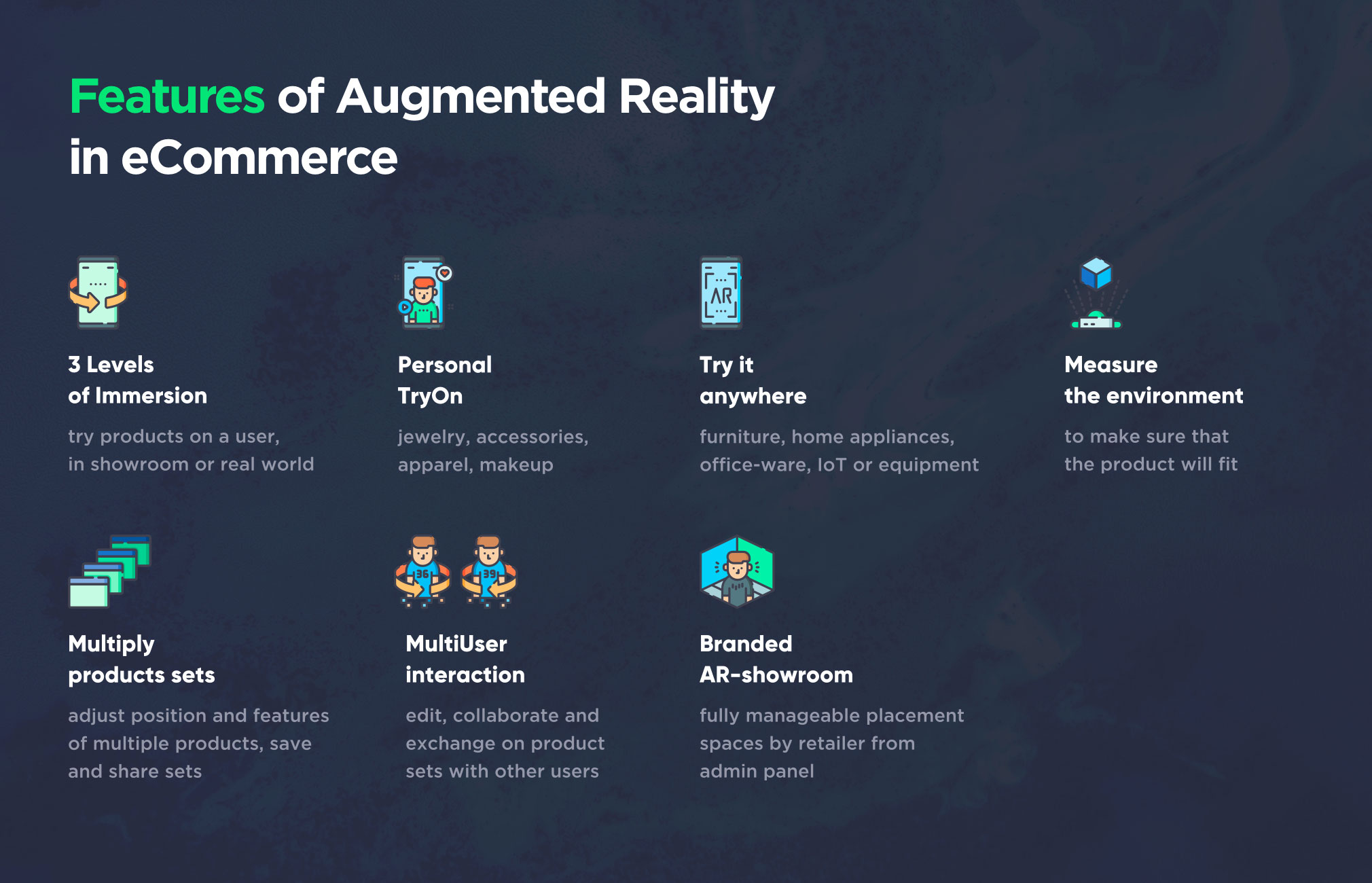AR in eCommerce
From online stores to augmented cyber-shopping: contemporary evolution of the way people shop
So let’s assume that you are already successfully using Magento 2. All modules were set up and work excellent, you have precise tracking of customers who’re falling to your funnel permanently, your conversion is awesome and your sky is clear. But what if your competitors also have all these benefits? Because, you know e-commerce is a highly competitive business and, as you probably heard, it takes all the running you can do, to keep in the same place. What if I tell, that we’re all standing at the edge of the new era in online shopping, driven by the emerging success of Augmented Reality.

“Try before buy” or the land of no product returns
I’m standing in front of the wall in my kitchen, trying to fit the new fridge into the corner, gradually realizing that this particular model is a little too big for the place.
This is the fifth model that I already tried and measures of my apartment pushing me to lower expectations and look for a more conventional and modest product than these cool french-door fridges.
From the side, the whole scene looks like I’m filming the wall with a smartphone and it’s upsetting me. But in fact, I’m using Augmented Reality to do online shopping in the most modern way — experiencing a product in my real conditions before pressing the buy button.
And the whole process of searching through a catalogue of goods and then trying them in your place is quite an interesting experience which, I believe, is the next big evolution leap in eCommerce.
AR in shopping is not only about trying things, although it’s a really valuable option. Technology has already reached the point when it’s reliable, simple and accessible enough for the majority of users on Earth. So it’s present and future impact is a result of a combination of features and solutions that are completely changing the way of how people are buying things.
So how AR transforms industries right now? I started from the try-into-environment feature because it’s the most popular and is used in various services by leading retailers such as IKEA, Amazon, and Shopify.
With over two million app downloads combined with the convenience of online shopping, it’s no wonder that IKEA’s website boasted 2.3 billion visitors in 2017 alone.
And after you tried to buy furniture or home appliances with augmented reality, you won’t do it in the other way ever again. Because the most obvious way to choose between different pieces of furniture is to try them and see how they fit. Not only the size, but also explore colors, materials, configurations, or create sets of multiple pieces, capture images, and share results. If a customer doesn’t want to make decisions alone, he can share augmented experience in real time with someone else and do the try-on in multiplayer mode.
All sounds like a huge benefit for customers, you may say, but what’s there for sellers?.
Two points. First, just imagine how all product returns caused by mismeasurements or misconception of the product via a photo are disappearing forever. How will it affect your logistics costs?

Secondary, meet new species of customers — Customer Augmented — people who don’t need to imagine a product’s look by a couple of 2D photos anymore. People who 100% sure in what they’re doing when tapping buy-button because it exactly meets their expectations. The impact of a few simple AR features is so huge, that those customers, who tried it, don’t want to go back to medieval online shopping. These people will love a new way they are shopping and will try to use new features as much as possible. So if you’re ready — they’re all yours.
“The new Audi R8 V10 pushes boundaries in terms of performance and innovation, so naturally we wanted to communicate with our potential customers in a similarly ground-breaking manner” — Kristian Dean, national communications manager for Audi UK
Probably you have come across face filters in Facebook, Instagram or Snapchat lenses every now and then. And this is Augmented Reality too. The same idea is being put behind the facial Try-on features developed for eCommerce. Now it’s the most interesting part for makeup and accessories stores, jewelry makers and apparel sellers. Customers can try on lipstick or shades in real time, changing colors and styles instantly in one click, capture results and share them to, let’s say, grab quick advice from stylist or friend. All beautiful little things like necklaces and earrings or tons of sunglasses — all can be tried-on in seconds, to assure the look is gorgeous.
Makeup Genius app by L’Oréal Paris boosted mobile makeup sales by 40%
All the above also means more satisfied customers, fewer expenses for samples, fewer product returns, and less necessity of showroom spaces for whole categories of products.

“Retailers are under increasing pressure to explain the purpose of physical stores, and take control of the fulfillment and return process for cross-channel execution,” said Hanna Karki, principal research analyst at Gartner.
Source: https://www.gartner.com/en/newsroom/press-releases/2019-04-01-gartner-says-100-million-consumers-will-shop-in-augme
Virtual Showrooms make a real impact
And when I’m saying showroom I mean good old brick-and-mortar space with lights, promo highlights, and smiling consultants. What if you created your own designed store in digital? It would be a lot more cost effective, reaching many more customers at the same time.
The main goal of any showroom is to showcase products, immerse customers into a specific mood, give them particular information and impression, to build an emotional connection and drive purchase. Traditionally it was a territory of real-world experiences — exam product, see it, feels it, touch it. Things changed. Meet AR Showrooms — virtual spaces with a real impact on sales. Completely interactive environment that can do all things, that real showroom can, and much more. A place that could be reached from anywhere at any time. A place with infinite space that looks like a convenient store but with digital catalogue, just like in the online shop. Place that you, as the seller, can set-up and change as frequently as you want, without extra investing.
You can integrate there all features of AR that I’ve already mentioned such as try-ons, and add a variety of important things like promo spots for discounts and season sales, best-sellers and merchandise, place banners, video advertisement, gamification features for loyalty programs, interactive marketing activations and easter eggs.
StepInShop — the combination of online and in-store shopping benefits using Augmented Reality a golden mean between online and offline shopping. The system based on the junction of surface tracking and face recognition technologies to achieve all-in-one solution for any product at any market.
But of course, as you probably know, everything comes with a cost. So what the price of transfer to the new age of shopping?
It does not exactly transfer, because we talking about augmented reality, it’s rather an augmentation of your current business. You don’t need to build a completely new solution to add AR features to your online shop. And don’t believe those developers, who’d insist on standalone application. All AR features I just wrote about, could be integrated into the current eCommerce application or online-shop as a completely manageable additional module. And, as we assumed at the beginning, you’ve already achieved success using various modules like Magento 2 for your online shop, so the process of integrating AR-module won’t be something new or troublesome.
Conclusion

So AR brought new tools and features in eCommerce but it’s not only about “features”. It’s a groundbreaking paradigm shift that leads to a new model of the customer journey with new possibilities we still have to explore. Customers who already had augmented experience are looking for relevant features and are paying more attention to AR in retail. Those who didn’t try AR yet, will try technology soon and probably join the first ones. This appearance of augmented cyber-shopping happens much quieter than, let’s say, PokemonGo introduction, but it affects much deeper levels of our daily life.
You can learn more about Augmented Reality in eCommerce and request a demo of ARCommerce solution at:










